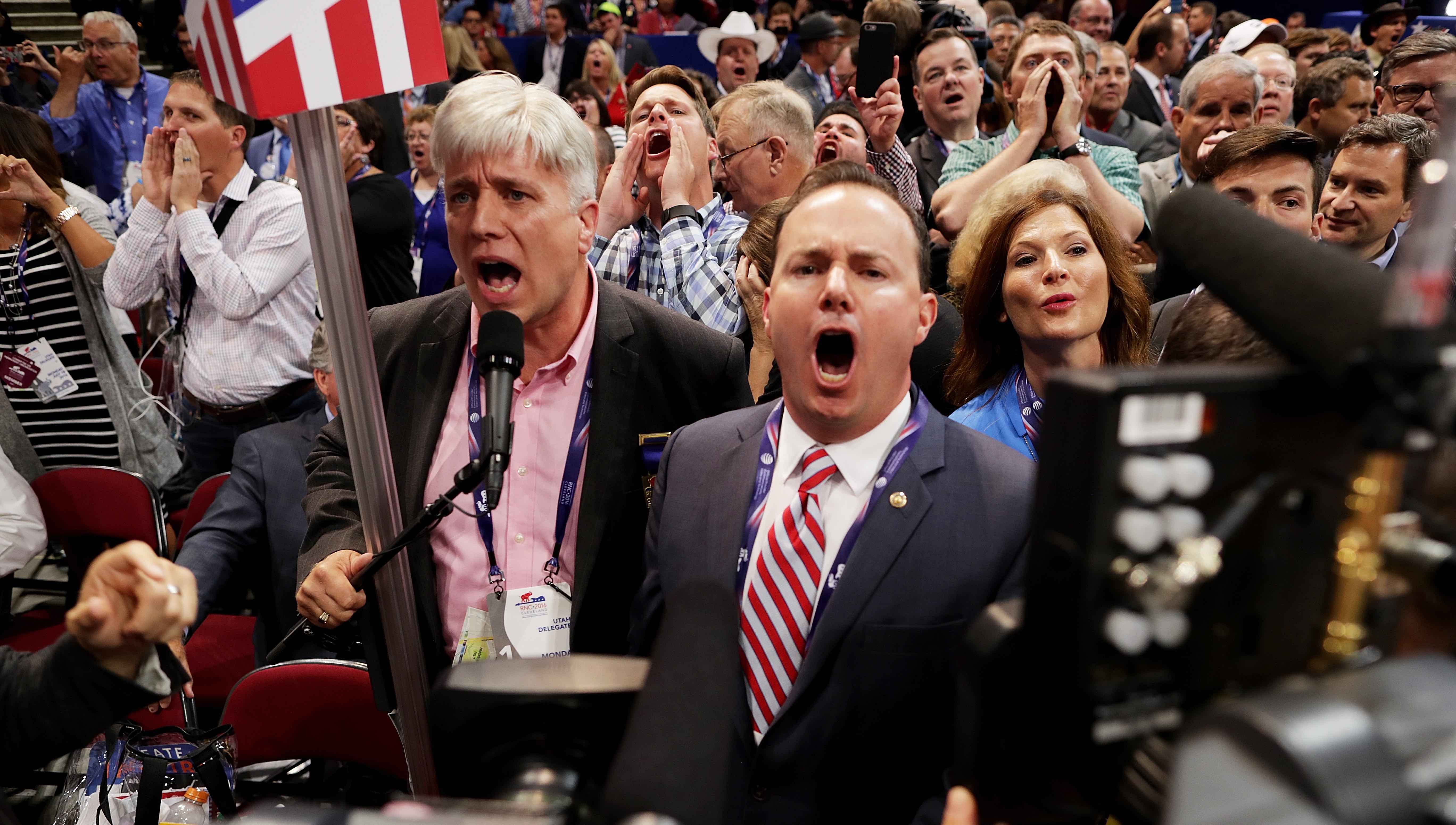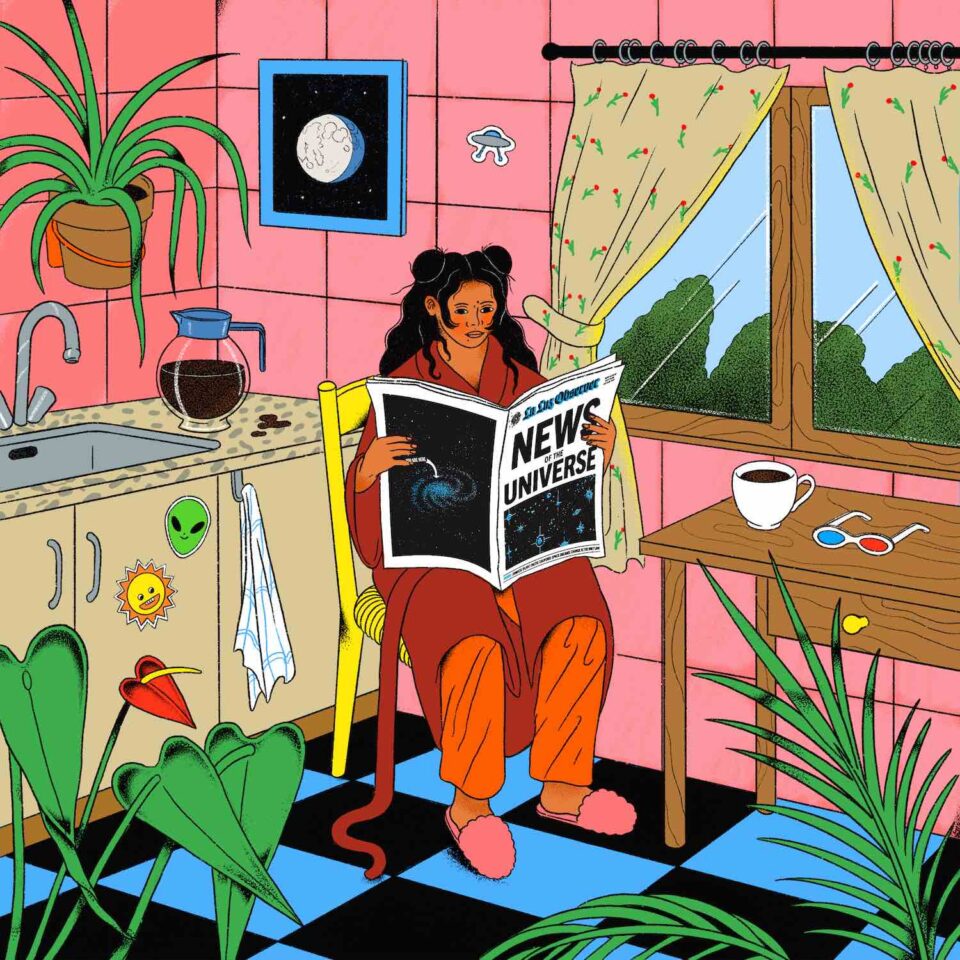FLOOD’s weekly Pop Culture Cure offers an antidote—or ten—to the most upsetting developments of the past week. (Because therapy’s expensive, and entertainment’s not.)
It seems like there’s been no avoiding Cleveland this past week. We’ve awoken to dark reflections on the night before; we’ve afternoon-snacked to the hype of the day’s scheduled speakers (and bizarro-world celebrities), and we’ve gone to sleep with the previous evening’s cris de coeurs still ringing in our ears. But it’s worth reminding ourselves that, unless we are actually there—and actually wallowing in that stew of noroviral expulsions, narcissm, and bananas and mildew—that the Cleveland conventional hall is just a state of mind; we have the power to go elsewhere. So let’s do just that. Let’s go elsewhere. What follows is a list of pop cultural paradises—places where all are welcome, where everyone knows your name, and where dreams go to thrive. Settle in.
The bar in Cheers
People look down on sitcoms because in many ways we’ve moved past them. We’re done with laugh tracks, and it’s hard to believe in characters that live on a set when HBO is flying actors to Mars for their latest “Gangsters in Space” series. But at the same time, if it makes us laugh, it makes us laugh, no matter how outdated the genre may be, and there’s a real charm to familiar people doing familiar things in a familiar place. Cheers is noteworthy because it’s really nothing special. It’s a traditional sitcom that takes place almost entirely on set, employs a stable cast of characters, and relies on a variety of lightweight storylines. Nevertheless, almost every episode feels fresh; the writing is just that good. The characters, over time, became so fully realized that they appear to have a repartee that is organic and entirely their own. The laughs feel earned, and they feel good.
Oh, and also any place that cheers a man (a Norm, more specifically) for the simple reason that he has entered a bar certainly can’t be faulted for being overly critical or judgmental. So let’s live there, maybe.
https://www.youtube.com/watch?v=EnTI45RvKsQ
The Land of Ooo in Adventure Time
The most horrible person who lives in the Land of Ooo is either: a former nerd who was cursed by a crown to live in an ice mountain and whose primary motivating force is a crippling lack of self-respect, or a lemon-headed creature who howls about disorder and who is also motivated by a deep loneliness. That means that in Adventure Time’s mythical setting, every major problem can be solved by love, friendship, and mutuality. (What a concept!) When Jake the Dog and Finn the Human fight a villain—and they most certainly fight, they are excellent fighters—the battle itself is almost always tangential to some other problem, and its resolution almost always comes about through diplomatic means. Even their chest-thumping bravado is understood to be absurd and cute (they are a boy and a dog, after all), a fact that’s not lost on either of them. A very special land indeed.
Plus there are people made of candy. That just sounds like it would be better than being made of flesh, blood, and water.
The campfire in Point Break
Point Break is not your standard surfer-action bank-robber-thriller. It is so un-standard, in fact, that Patrick Swayze (a.k.a. “Sex: E, Swayz: E”) is the leader of this gang, and the only thing he wants more than big money is big waves. And really, that little bit of insanity is the only way this movie makes any sense at all. Only Patrick Swayze is good-looking enough to think that Keanu Reeves is “just a guy who likes sandwiches who wants to be my bro and maybe rob some banks while wearing presidential masks with me and my other bros.” Only thus are we able to enjoy the company of these xxxtreme dudes while they take a load off, relax (intensely), and sit around a beach campfire. And if there is anything that can rival the thrill of riding the big one, it is listening to two chill-ass bank-robbing bros just chilling the hell out (again, intensely) in front of a fire.
The Shire in The Lord of the Rings
How fun would it be to just hang out in the Shire and never have to go saving the world with a bunch of cos-play fantasy dorks?! Pretty fun, right? The Shire has all the ingredients for a pretty great party: lots of ale, lots of hair, lots of whimsy, and lots of really tiny doors. That is a recipe for one million laughs tonight, and the same again tomorrow morning (when full-sized adults try to open the bathroom door and are clotheslined by low-lying beams). If the world can’t learn to live in Shire-ly peace, let the world burn, I say. To you, Frodo Baggins. To you.
https://www.youtube.com/watch?v=YGb77HflP8A
The Pop Culture Happy Hour recording studio
Even with Grantland and The Dissolve now defunct, there’s still a bunch of quality pop cultural roundtables out there. NPR’s Pop Culture Happy Hour has been in the game longer than most others, but it retains its youthful charm through the sprawling nature of the discussions and the enthusiasm of its host, Linda Holmes. (The show also typically features A.V. Club founding editor Stephen Thompson, superhero biographer Glen Weldon, and a variety of other NPR personalities.) Holmes sets the parameters for the discussions (managing to find interesting angles of approach on even the most hackneyed subject), presides over the occasional low stakes pop quiz, and generally ensures that everyone is relaxed, generous, and relatively on topic. So if you’re tired of hot takes and pretense and interested in finding the next great romance novelist, this is the roundtable for you.
The music store in High Fidelity
The point of High Fidelity is that John Cusack is immature and only when he grows up can he recapture the heart of his beloved and achieve his dreams and blah blah blah etc. Those things all matter and are pleasant to watch and all, but really, the star of the show is John Cusack’s record shop, its employees (played with atomic aplomb by Jack Black and Todd Louiso), and the soundtrack that it conveniently enables. In this record shop, dreams are forestalled, lists are made, and emotional tribulations are put to the side. And what more could any of us ask for, really?
PS: Holy shit John Cusack’s character in this movie is insufferable.
The Emporium in Dazed and Confused
The Emporium, in case you forgot, is the local drive-through joint in Dazed and Confused (Richard Linklater’s ode/takedown of high school life and culture). It is also a place that everyone can recognize: It’s the bleachers beside the football field or the lawn in front of the woodshop—it’s the place that everyone in high school knows goes to in order to see what’s going on with everyone else before everyone else breaks off and goes their separate ways. And even though it is realized in exceptionally vivid detail here (including the iconic appearance from Matthew McConaughey), it also remains archetypal. It’s got upperclassmen, underclassmen, bullies, bullied, nobodies, jocks, freaks, iconoclasts, dorks, and cheerleaders. We may not all be Texans, but everyone can find a place here.
The prep room in Party Down
Party Down is one of the great failures of modern television. “Great” because it was always funny, always poignant, and always insightful; and a “failure” because it failed to find an audience of alive human beings. But even though it didn’t survive to a third year, it’s still worth celebrating this upstairs/downstairs comedy/drama that never really had an upstairs to speak of, and it’s also worth noting that since the show was cancelled, its cast has dominated pop culture: Jane Lynch now presides over Glee; Lizzy Caplan has first choice among all the finest indie films; Adam Scott is the man who would be Paul Rudd; and Martin Starr is that guy in the background of everything that’s great that somebody’s friend once told you about, you think. Maybe. And this makes sense, because they’re all great, but they’ve never been better than they were on Party Down, when they were all adorable misfits wearing pink shirts and working in catering. If this is failure, then God bless failure. (And actually, God bless failure either way.)
The theme park in Adventureland
Summer jobs are the worst, but sometimes also the best. The confusion of that moment—when you simultaneously resent the hot dog hat on your head but also crush heavily on the hot-dog-hat-wearing-employee beside you—is what makes high school movies so popular. Or it’s at least what made them so popular before the 1980s ended and we forgot about them. Adventureland solved this problem by setting its action back in high school’s prime: the late ’80s, but it also approaches the material with a sensibility that is much less…pointed.
The characters here grow a little, and learn a little, and yeah, there’s a little moralizing at the end. But the movie itself is much more interested in just being there, back in that time and place. The place, in this case, is a small Pittsburgh amusement park where Jesse Eisenberg winds up after his summer plans fall apart. His friends go on European tours, but he finds Kristen Stewart and realizes that, wherever you go when you’re 21, you still have a long way to travel. Jesse Eisenberg also learns that it is better to punch others in the nuts than to be punched in the nuts yourself. (Literally, not metaphorically.) This is post–high school, pre-adulthood life par excellence…sans France, avec Ryan Reynolds.
https://www.youtube.com/watch?v=wvrzD7YLaaY
The Community study room
Everything is possible in the Community study room, and if something is possible at Greendale Community College, rest assured that it will be done. Abed (Danny Pudi) will have a mental breakdown and come to believe that his entire study group has turned into Claymation characters; Troy (Donald Glover) will be accepted into the prestigious “elite air conditioning repair program” and yet neglect to enlist; Pierce (Chevy Chase) will betray his friends at every opportunity; and Jeff (Joel McHale) and Annie (Alison Brie) will stubbornly refuse to fall in love. Expectations will be bucked, tropes will be subverted, in-jokes will be made, and nonetheless, it will all end in laughs and heartwarmth. That is the miracle of Community. It offers both the deconstruction of the sitcom and also the reinvigoration of the same.







